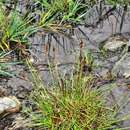mk
имиња во трошки


Monocotyledon a phlanhigyn blodeuol yw Ffug-hesgen sy'n enw benywaidd. Mae'n perthyn i'r teulu Cyperaceae. Yr enw gwyddonol (Lladin) yw Kobresia simpliciuscula a'r enw Saesneg yw False sedge.[1] Ceir enwau Cymraeg eraill ar y planhigyn hwn gan gynnwys Ffug-hesgen.
Mae'r planhigyn hwn yn tarddu o Asia a throfannau De America. O ran ffurf, mae'n eithaf tebyg i wair, glaswellt neu frwyn, ond y prif nodwedd sy'n eu gwahaniaethu yw bonyn y planhigyn. Mae gan y bonion hyn - o'u croes-dorri - siap triongl ac mae'r dail yn sbeiralu mewn tair rheng - dwy sydd gan wair.[2][3]
Monocotyledon a phlanhigyn blodeuol yw Ffug-hesgen sy'n enw benywaidd. Mae'n perthyn i'r teulu Cyperaceae. Yr enw gwyddonol (Lladin) yw Kobresia simpliciuscula a'r enw Saesneg yw False sedge. Ceir enwau Cymraeg eraill ar y planhigyn hwn gan gynnwys Ffug-hesgen.
Mae'r planhigyn hwn yn tarddu o Asia a throfannau De America. O ran ffurf, mae'n eithaf tebyg i wair, glaswellt neu frwyn, ond y prif nodwedd sy'n eu gwahaniaethu yw bonyn y planhigyn. Mae gan y bonion hyn - o'u croes-dorri - siap triongl ac mae'r dail yn sbeiralu mewn tair rheng - dwy sydd gan wair.
Die Zweiteilige Schuppensegge (Kobresia simpliciuscula (Wahlenb.) Mack., Syn.: Carex simpliciuscula Wahlenb.), auch Seggen-Schuppenried,[1] Zweiteiliges Schuppenried oder Kobresie genannt, ist eine Pflanzenart aus der Gattung der Schuppenseggen (Kobresia) innerhalb der Familie der Sauergrasgewächse (Cyperaceae). Sie ist auf der Nordhalbkugel weitverbreitet.
Die Zweiteilige Schuppensegge ist eine ausdauernde krautige Pflanze, die Wuchshöhen von 3 bis 20, bis zu 30 Zentimetern erreicht. Sie wächst rasenförmig. Die starr aufrechte Stängel sind etwa 1 Millimeter dick, glatt oder nur oben etwas rau, fast stielrund oder undeutlich dreikantig.
Die Blattscheiden sind hellbraun und matt. Die Blattspreiten sind schmal, bis etwa 2 mm breit, kürzer als der Stängel und am Rand rau.
Die Blütezeit liegt zwischen Juli und August. Der endständige Blütenstand ist 1 bis 3 Zentimeter lang und aus dicht gedrängten Ähren zusammengesetzt, von denen jede wieder aus mehreren Ährchen zusammengesetzt ist. Die Ährchen sind am Grunde weiblich, im oberen Teil männlich. Das Tragblatt der untersten Ähre hat oft eine laubartige Spitze und ist so lang wie die Ähre. Die Tragblätter der einblütigen Ährchen sind etwa 4 Millimeter lang, gekielt, rotbraun und am Rand weißhäutig. Die männlichen Blüten enthalten drei Staubblätter. Die weiblichen Blüten enthalten drei Narben. Die Frucht ist am Griffelrest stachelspitzig und etwa 3 Millimeter lang.
Die Chromosomenzahl beträgt 2n = 76.[2]
Kobresia simpliciuscula ist auf der Nordhalbkugel weitverbreitet. Das weite Verbreitungsgebiet reicht von Nordeuropa, den Pyrenäen, Alpen und den Karpaten bis zum Kaukasus und vom subarktischen Nordamerika mit Grönland bis zu den westlichen Vereinigten Staaten.[3]
Sie gilt in Mitteleuropa als ein Eiszeitrelikt.[4] In Mitteleuropa ist sie insgesamt sehr selten, und sie fehlt dort in weiten Gebieten. Sie bildet aber an ihren Standorten meist kleinere Bestände, so beispielsweise im Wallis, im Berner Oberland, in Graubünden in den Berchtesgadener Alpen, in den Hohen Tauern und in der Obersteiermark.[4]
Sie wächst in Mitteleuropa meist ind Höhenlagen von etwa 1700 bis 2500 Metern.[4] Sie gedeiht in den Alpen in Höhenlagen von 1300 bis 2620 Metern.
Die Zweiteilige Schuppensegge gedeiht am besten auf durchrieselten, basenreichen und meist kalkhaltigen, lockeren auf sickernassen, Kies- oder Sand-Böden.[4] Sie erträgt Kälte. Sie kommt in Mitteleuropa nur an sickerfeuchten Hängen, an kiesigen oder sandigen Ufern alpiner Bäche und Rinnen vor.[4] Die Zweiteilige Schuppensegge kommt im Gesamtverbreitungsgebiet in Quellfluren, in Flachmooren, auf Kiesbänken vor. Kobresia simpliciuscula ist eine Kennart des Kobresietum simpliciusculae aus dem Verband Caricion bicolori-atrofuscae.[5]
Die ökologischen Zeigerwerte nach Landolt et al. 2010 sind in der Schweiz: Feuchtezahl F = 4fw+ (sehr feucht, stark wechselnd, im Bereich von fließendem Bodenwasser), Lichtzahl L = 5 (sehr hell), Reaktionszahl R = 4 (neutral bis basisch), Temperaturzahl T = 1+ (unter-alpin, supra-subalpin und ober-subalpin), Nährstoffzahl N = 1 (sehr nährstoffarm), Kontinentalitätszahl K = 3 (subozeanisch bis subkontinental).[6]
Die Erstveröffentlichung erfolgte im Jahre 1803 durch den schwedischen Botaniker Göran Wahlenberg unter dem Namen (Basionym) Carex simpliciuscula. Die Neukombination zu Kobresia simpliciuscula (Wahlenb.) Mack. wurde 1923 durch Kenneth Kent Mackenzie in Bulletin of the Torrey Botanical Club, Volume 50, Issue 11, S 349 veröffentlicht.[7] Weitere Synonyme für Kobresia simpliciuscula (Wahlenb.) Mack. sind: Kobresia caricina Willd., Kobresia bipartita (All.) Dalla Torre.
Die Zweiteilige Schuppensegge (Kobresia simpliciuscula (Wahlenb.) Mack., Syn.: Carex simpliciuscula Wahlenb.), auch Seggen-Schuppenried, Zweiteiliges Schuppenried oder Kobresie genannt, ist eine Pflanzenart aus der Gattung der Schuppenseggen (Kobresia) innerhalb der Familie der Sauergrasgewächse (Cyperaceae). Sie ist auf der Nordhalbkugel weitverbreitet.
Kobresia simpliciuscula is a species of sedge known by the common names false sedge,[2] simple bog sedge[3] and simple kobresia. It has a circumpolar distribution, occurring throughout the northern latitudes of the Northern Hemisphere.[1]
This perennial plant forms tufts of several triangular stems reaching up to 50 centimeters in height. It has short rhizomes. The leaves are up to 20 centimeters long. The inflorescence contains up to 12 spikes of flowers.[1][4][5] Light is required for the seeds to germinate.[5]
This plant occurs on tundra and in alpine climates. It grows in wet habitat types such as ponds and meadows. It often grows in calcareous substrates such as limestone.[5]
Kobresia simpliciuscula is a species of sedge known by the common names false sedge, simple bog sedge and simple kobresia. It has a circumpolar distribution, occurring throughout the northern latitudes of the Northern Hemisphere.
This perennial plant forms tufts of several triangular stems reaching up to 50 centimeters in height. It has short rhizomes. The leaves are up to 20 centimeters long. The inflorescence contains up to 12 spikes of flowers. Light is required for the seeds to germinate.
This plant occurs on tundra and in alpine climates. It grows in wet habitat types such as ponds and meadows. It often grows in calcareous substrates such as limestone.
Rěznojta kobrezija (Kobresia simpliciuscula (Wahlenb.) Mack., syn. Kobresia caricina, Kobresia bipartita) je rostlina ze swójby cachorowych rostlinow (Cyperaceae).
Rěznojta kobrezija (Kobresia simpliciuscula (Wahlenb.) Mack., syn. Kobresia caricina, Kobresia bipartita) je rostlina ze swójby cachorowych rostlinow (Cyperaceae).